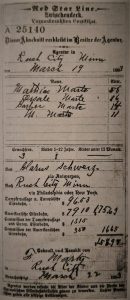The fall semester and our Cultural Crossroad’s project have both come to an end.
There are many things I learned this semester, but I believe that there are three main lessons that have been the most valuable to me. The have been creating a blog and a website, learning more about the Apostolic Church, and learning about the Stevens County Historical Society.
Had it not been for this project, I probably would have never gone into the Historical Society. I’ve driven past it a million times and have always admired the structure of the building but never really considered it as a place the general public could visit. I am excited to continue my new relationship with the organization and already have plans to work with them on community project. I also hope that Joy and I will be able to present our website to team at the Historical Society and that there may be something we have presented that will be of use to them.
It is really hard for me to put into words what I have learned about the Apostolic Church. Part of this project was very personal for me and emotionally taxing at times. I often depended on Joy to help take some emotion out of my work and step back to consider what I was doing from a historian perspective rather than a community member perspective. At times it was also difficult for me because the migration story of the Apostolic Church is a part of my husband and children’s heritage. Joy and I had many conversations over our believes and feelings and at times we had to set those aside to tell the Apostolic story in an honest and respectful way. Whether we agree or disagree with Apostolic believes or traditions, we knew we needed to focus on the goal of telling the story. I thought it was very interesting in our presentation when one lady said that she thought our site was impersonal and 3rd person. In a way I looked at that as a compliment because in creating it, it certainly didn’t feel impersonal, especially for me. I attend the Apostolic Church with my husband’s family, most of my husband’s relatives are members of the church, and on the other side I’m very active in the Hispanic/Mexican community. I am the Executive Director for a local nonprofit which helps and advocates for Latino families in Stevens County, I teach ESL, most of my girlfriends are Mexican, I occasionally attend Spanish Catholic services with my Mexican friends, and I participate in events at the Spanish Evangelical Church. It was very hard to me to be in 3rd person. I truly hope that we were honoring to both groups.
Lastly, the skills I learned in creating the blog and website were invaluable! I appreciate that we were able to create both so we could see the difference. I also appreciated that it was really just thrown at us. It caused me to explore on my own and search out solutions. Although it was scary at first, I got to the point where I was spending ridiculous amounts of hours fussing over my blog and our website just because I loved doing it and I wanted to learn as much as possible. I am excited to take these skills and create a website for the nonprofit I work for and anyone else that wants a website. Who knows how far this could go. I have even thought about creating something for myself. This will definitely be a skill that I will use and improve on!
Overall my experience with Cultural Crossroads was amazing and I’d definitely recommend COPLACDigital courses to anyone interested. I look forward to sharing the website Joy and I created with the Morris, Apostolic, and Latino communities in Stevens County.
Here is a link to our finished project! Toward a Better Land
